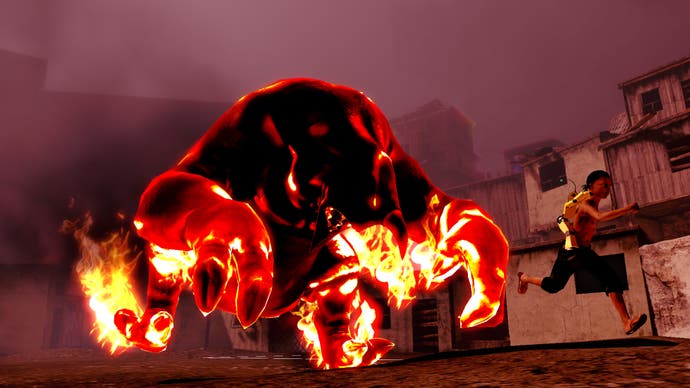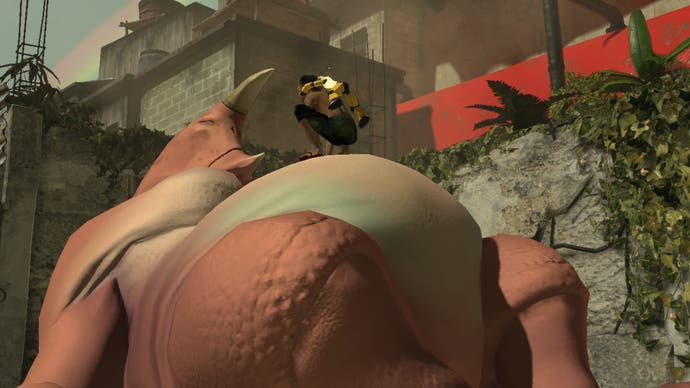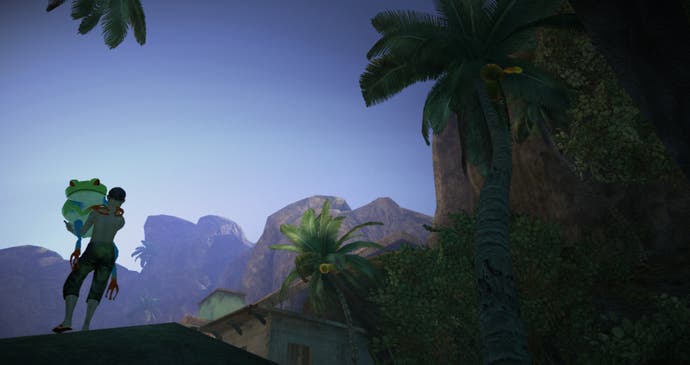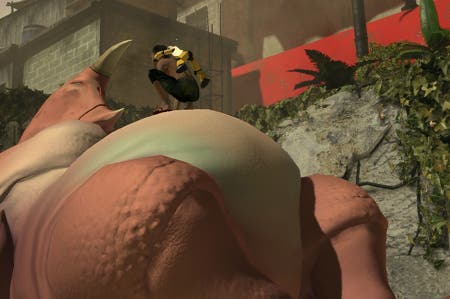Papo & Yo Preview: A Personal Puzzler
The drunk guardian.
If the creators of Indie Game: The Movie make a sequel I'd be shocked if it doesn't co-star Vander Caballero. The Montreal-based designer had a successful career at EA working on games like Army of Two and FIFA Soccer 2004 when he decided he'd had enough. He needed to make his own game; one that told his story.
His upcoming PSN title, Papo & Yo is an autobiographic tale about his childhood, particularly his relationship to his abusive, alcoholic father. Rather than make a literal translation of his upbringing, Caballero re-imagines his life as a small boy named, Quico, befriending a monster.
The monster, simply called 'Monster' is a giant pink rhinoceros-like beast. Much of the time, Monster is a gentle, lovable creature that protects Quico. However, he's addicted to frogs, and when he eats said amphibians he goes berserk and rages on his best pal. The earlier version of Monster shown at E3 resembled a rhino much more, but Caballero realized that he looked more like a pet than his father.

"I wasn't scared of the monster," he told me at a recent press demo. To overcome this, he had his friend, Nilo Rodis-Jamero (an art director whose credits include Raiders of the Lost Ark and the original Star Wars trilogy) redesign the beast so its head looked more like a beetle, with menacing beady eyes.
Papo & Yo will be a puzzle game in the vain of Ico, but the pace of puzzle solving will change dramatically. When Monster is in a relaxed mood this will be a peaceful process, while it will be much more frantic if Monster is intoxicated. The E3 demo portrayed Quico kicking a soccer ball to lure Monster around, because as Caballero is quick to point out, "you can't control a person." Sadly, the new interactions with Monster aren't being shown just yet, but Caballero promises they'll be "very touching at some points, and very terrifying at others."
There won't be any fail states in Papo & Yo. Caballero was vocal about death being a fallacy in games. "Dying is just punishment. It's not actually dying. So I asked how do we bring that concept further? So we decided that when you fall into the water, you'll spawn all wet. That will create a really interesting connection to the spawning... it closes the loop in a really interesting way."
The new demo shown off at GDC begins with Quico emerging in a favela next to an abstract chalk scrawl. He sees a girl off in the distance holding a piece of white crayon. Entranced by the only other person in this empty village, Quico gives chase. Caballero tells me the girl's name is Alejandra and she wields a magic crayon. "She likes you, but she's afraid of you, because you want to hang out with a monster."

As he explores the favela he encounters more chalk drawings. These usually portray gears and switches. When he activates the drawings, the landscape changes. A set of stairs or a bridge may appear, or in later cases houses will have illustrated wind-up gears on them that cause the dwellings to sprout tiny line-drawing legs and scurry around.
The environment is a particular highlight. We rarely see favelas that aren't simply playgrounds for shooters. The South American setting is full of colour, with pink and blue abodes piled on top of one another to create an art deco montage surrounded by lush green flora. At one point Quico emerges from an elevator to a view of a rickety tower made of houses that are stacked on top of each other. Upon discovering this scene the music swells in an upbeat, yet haunting tempo that I probably could have listened to all day. "You'll hear instruments in this game that you've never heard before," Caballero says. "Like the jaw of a dead cow."
At the end of the demo Quico catches up with Alejandra only to be transported to a dimly lit black and white scene where the only splash of colour is a red car parked in a road. The modern, realistic look is a stark contrast to the bright whimsical world we've explored thus far. A chalk outline leads Quico to the front of the car as we slowly follow its path. We can't run or jump. Through the windshield we see two male figures. An older Quico and his father, perhaps? Before this mystery is revealed, the demo ends.

I asked Caballero if you'll be able to explore any of these black & white scenes later and with the same sort of freedom as the rest of the game. "No," he replies. "When you're moving around this scene, your brain is creating a memory that matches with the game." The sluggish movements are necessary to cement these events in the player's mind. There won't be any moral choices either as this is a very authored narrative. "This is my story. You can't escape it."
While Papo & Yo is centered around Caballero's relationship to his father, it's about more than that. Caballero showed me a document explaining the theme between each of the game's five chapters. "Act one is my childhood," Caballero explains, with the document indicating that covers the first five years of his life. "Years 5-10 is my mother and my protection when I realised my father was an evil bastard. Act three is from 10-15; it's me and my brother protecting each other. 15-25 is Act four, it's about rage... Act five is finally my liberation from 25-37." Caballero notes that this isn't a literal storyboard -- there won't be a mother or brother actually in the game -- but these are the stages of his life he's trying to convey through Quico's journey.
Caballero then admits Alejandra is based on his first love who later broke his heart. When asked if the person she was based on knows about her role in the game, Caballero laughs, "No. I'm going to have to do it, but I don't know how. I may have to talk to my lawyer about it." Though behind the laughter I could sense a genuine concern for when this day would come. Caballero may not be able to escape reality, but he now wields the magic crayon.

